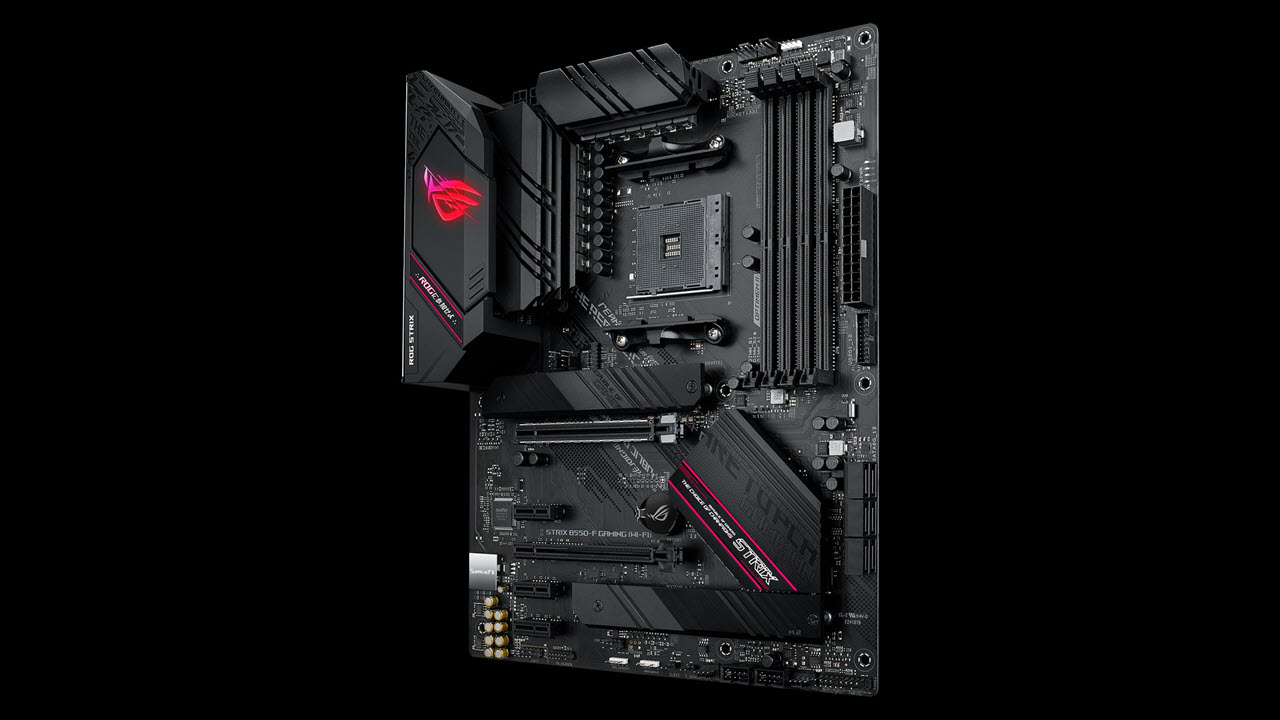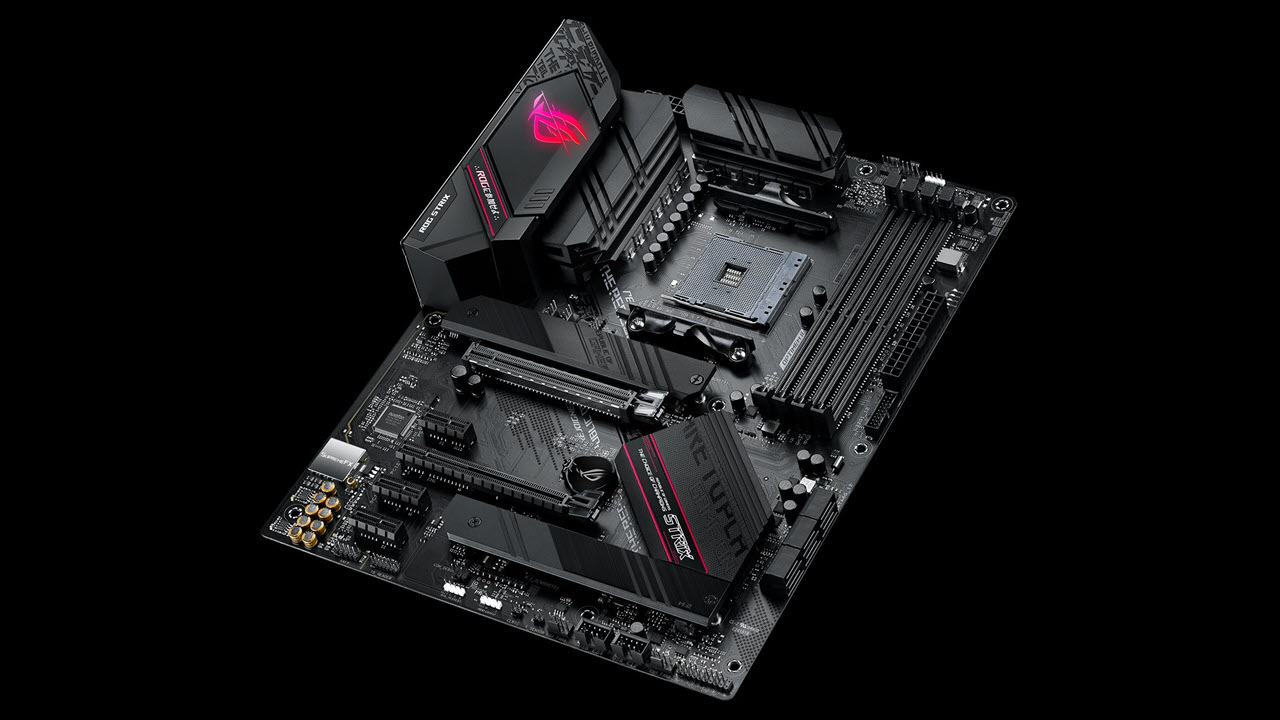Tom's Hardware Verdict
Asus’ ROG Strix B550-F Gaming Wi-Fi delivers premium features including SupremeFX Audio, Intel Wi-Fi 6 AX200, solid power delivery and more. It’s a good option around the $200 mark, though there are similarly specced boards that cost less.
Pros
- +
Capable 14-Phase Power Delivery
- +
2.5 GbE LAN and Wi-Fi 6 AX200
- +
Premium Audio
Cons
- -
Still seems expensive for B550
Why you can trust Tom's Hardware
After reviewing Gigabyte B550’s Aorus Master, we found for X570-level pricing, you can get most of the features and capabilities of the generally more expensive platform. The Asus ROG Strix B550-F Gaming Wi-Fi we’re looking at here costs less at $209.99 (or about $20 less for the non-Wi-Fi model) but still comes with a lot of appreciated features.
Asus’ B550 product stack currently consists of 11 boards that range in price from $134 (Prime B550M-A) up to the B550-E Gaming with an MSRP of $279. In between are several options that include boards from the ROG Strix, TUF, and Prime lineups. Within this lineup are ATX, Micro-ATX, and Mini-ITX size boards, all designed to support the latest AMD Ryzen processors.
Sitting second from the top of Asus’ B550 motherboards, the B550-F Gaming Wi-Fi includes 14-phase power delivery, 2.5 GbE LAN, integrated Wi-Fi 6 AX200, two M.2 slots (each with a heatsink), six SATA ports and premium audio, among other features.
In our testing, the B550-F Gaming Wi-Fi performed well, matching the other boards we’ve tested so far. We didn’t come across anything out of the ordinary during our stock runs. With optimized defaults set, the B550-F Gaming Wi-Fi had no issues boosting to the factory 4.6 GHz clock speed. Overclocking the 12 core 24 thread Ryzen 9 3900X also went without an issue. Our sample was able to push all cores and threads on the CPU to 4.3 GHz, while running our 4x8 GB RAM KIT at DDR4 3600 with Infinity Fabric 1:1 to the memory speed.
Specifications
| Socket | AM4 |
|---|---|
| Chipset | B550 |
| Form Factor | ATX |
| Voltage Regulator | 14 Phase (12+2) |
| Video Ports | (1) HDMI (v2.1), (1) DisplayPort (v1.2) |
| USB Ports | (1) USB 3.2 Gen 2, Type-C (10 Gbps), (1) USB 3.2 Gen 2, Type-A (10 Gbps), (4) USB 3.2 Gen 1, Type-A (5 Gbps), (2) USB 2.0, Type-A |
| Network Jacks | (1) 2.5 GbE |
| Audio Jacks | (5) Analog + SPDIF |
| Legacy Ports/Jacks | ✗ |
| Other Ports/Jack | ✗ |
| PCIe x16 | (1) v4.0 (x16), (1) v3.0 (x4) |
| PCIe x8 | ✗ |
| PCIe x4 | ✗ |
| PCIe x1 | (3) v3.0 (x1) |
| CrossFire/SLI | 2-Way CrossfireX |
| DIMM slots | (4) DDR4 4400+(OC) 128GB Capacity |
| M.2 slots | (1) PCIe 4.0 x4 / SATA + PCIe, (1) PCIe 3.0 x4 / SATA + PCIe |
| U.2 Ports | ✗ |
| SATA Ports | (6) SATA3 6 Gbps (Supports RAID 0, 1 and 10) |
| USB Headers | (1) USB v3.2 Gen 1, (2) USB v2.0 |
| Fan/Pump Headers | (6) 4-Pin |
| RGB Headers | (2) RGB, (1) ARGB |
| Legacy Interfaces | ✗ |
| Other Interfaces | FP-Audio, TPM |
| Diagnostics Panel | Yes (4 LEDs) |
| Internal Button/Switch | ✗ |
| SATA Controllers | ✗ |
| Ethernet Controller(s) | Intel I225-V (2.5 GbE) |
| Wi-Fi / Bluetooth | Intel Wi-Fi 6 AX200 / Bluetooth 5.1 |
| USB Controllers | ✗ |
| HD Audio Codec | SupremeFX S1220A |
| DDL/DTS Connect | ✗ / Yes |
| Warranty | 3 Years |
Features
Here’s a list of what ships in the box with this ATX board:
- User manual
- Wi-Fi antenna
- Support DVD
- Case badge / ROG Strix Stickers
- ARGB LED extension cable
- Four SATA cables
- M.2 Rubber Packages
- M.2 SSD screw packages
- Cable ties
- ROG thank you card





At first glance, what stands out with this board are the black PCB, heatsinks and slots. The only components that are not black are highlights on the chipset heatsink, along with the ROG Name and ROG symbol (LEDs) on the IO shroud. In addition, slogans such as “Game On” and others can also be seen in black on the IO shroud.
Like the other B550 boards we’ve looked at so far, the ROG Strix B550-F Gaming Wi-Fi does not have a fan on the chipset heatsink as the B550 chipset itself uses less power because it doesn’t have to support as many PCIe 4.0 lanes. Given the dark overall theme, this board should match most build themes.
Get Tom's Hardware's best news and in-depth reviews, straight to your inbox.
Starting off at the top of the board, the IO shroud reaches out over the rear IO bits and partially covers the large VRM heatsink on the left. Above that are two EPS connectors, one 8-pin (required) and a 4-pin (optional). Moving right, across the top are two (of six) 4-pin PWM/DC fan/pump headers, along with the first RGB header (of three). There are two additional fan headers located to the right of the IO shroud and above the top M.2 slot. All fan headers are able to output up to 1A/12W, which is adequate for a majority of fans and AIOs.
The board sports four single-side latching DIMM slots capable of holding up to 128GB of DDR4 Memory. Memory speed is listed up to DDR 4400(OC), which is notably less than the B550 Aorus Master and MSI MAG B550 Tomahawk. That said, AMD’s self-proclaimed sweet spot for memory is in the DDR4 3600-3733 range, which also keeps the infinity fabric (IF) at a 1:1 ratio with the RAM speed. Once past that, the IF ratio isn’t 1:1 and latency increases dramatically. So most users should probably stick to memory speeds below 4000.
Located on the far right side of the board is a 24-pin ATX connector, along with a front-panel USB 3.2 Gen1 (5 Gbps) header. Just above these are four LED lights (Asus calls these Q-LEDs) that light up during the motherboard booting process, checking key components such as VGA, CPU, DRAM and Boot. If an error is found, the critical component’s LED stays lit until the problem is resolved. This is convenient when troubleshooting POST issues, especially when the board doesn’t have a debug LED screen to display specific codes.
\The EPS power plugs feed a 14-phase (12+2) VRM controlled by Asus’s Digi+ 6 channel controller (ASP1106GGQW). This in turn sends power to the “Teamed” MOSFETs (Vishay SIC639 50A) that yields 600A capacity for the CPU/Vcore. This isn’t the most robust power delivery we’ve seen so far, but this setup was plenty capable of handling our Ryzen 9 3900X without causing issues or running too hot. That said, it did run roughly 10 degrees Celsius higher than the other boards, though it was still well within operating parameters at stock and overclocked.
Sliding down to the bottom half of the board, the audio section is found on the far left and is mostly uncovered, outside of the SupremeFX audio chip hidden under a shiny faraday cage to prevent EMI. Also visible are the Nicicon audio capacitors, along with two op-amps. Input sensitivity is automatic and ranges from 32-600 ohm-headphone impedance, allowing greater flexibility and proper output. The premium audio section will be adequate for most users.
In the middle of the board we see two full-length PCIe slots with the primary GPU slot reinforced (Asus calls this Safeslot) to prevent sagging and shearing from heavy video cards. The top slot is fed from the CPU, providing 16 PCIe 4.0 lanes. The second full-length slot is fed from the chipset, running at PCIe 3.0 x4 speeds. Two-Way CrossfireX is supported. In addition to the full-length slots, the B550-F Gaming Wi-Fi provides an additional three PCIe 3.0 x1 slots.
Also found in the middle of the board are two M.2 sockets. Both support M.2 modules up to 110mm in length, of both PCIe- and SATA-based variety. Additionally, both sockets have their own individual heatsinks to keep hot-running NVMe drives cool. The top slot is PCIe 4.0 x4, while the bottom slot is limited to PCIe 3.0 x4, since those lanes come from the chipset.
On the right edge of the board are six SATA3 6Gbps ports, all fed from the chipset. These ports support RAID 0, 1 and 10. Port sharing is inevitable on this chipset, and the ROG Strix B550-F Gaming Wi-Fi shuts down SATA ports 5/6 when any M.2 module is installed in M.2_2 (the lower socket).
Across the bottom edge of the B550-F Gaming Wi-Fi are several headers that cover USB, fan control, audio, and more. Below is a list of the headers and jumpers here, from left to right.
- Front panel audio
- Thunderbolt header
- RGB header / Aura aRGB header
- Clear CMOS header
- Temperature sensor header
- Chassis fan header
- (2) USB 2.0 headers
- Chassis fan header
- System panel header
The rear IO area on our B550-F Gaming Wi-Fi has enough connectivity to keep most users happy. There’s a total of eight USB ports -- two USB 3.2 Gen2 (Type-A and Type-C), four USB 3.2 Gen1 and two USB 2.0. One of the USB 2.0 ports is designated for BIOS FlashBack functionality (flashing the BIOS without a CPU), a feature that can be particularly handy for AM4 boards, given the multitude of CPU models. The single Intel 2.5 GbE LAN port is next to the HDMI and DisplayPort video outputs. The audio stack consists of standard 5-plug analog outputs plus SPDIF. Last but not least are two antenna connections for the included Wi-Fi.

Joe Shields is a staff writer at Tom’s Hardware. He reviews motherboards and PC components.
-
AlB80 This board has bad designed VRM (4+2).Reply
There is no consumer PSU that can take 150A pulses (triple Vishay SiC639) at 12V.
So this mobo can roast your PSU for you.



